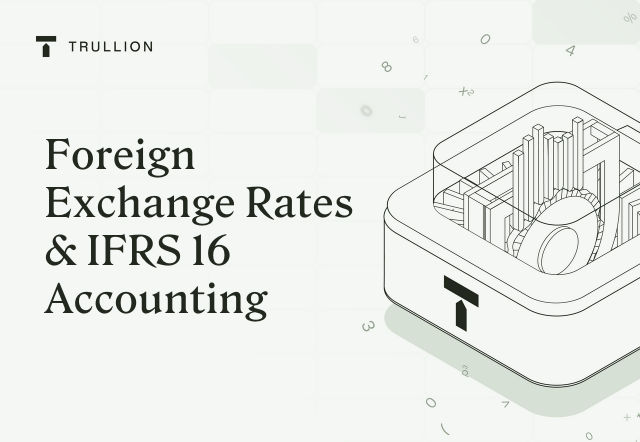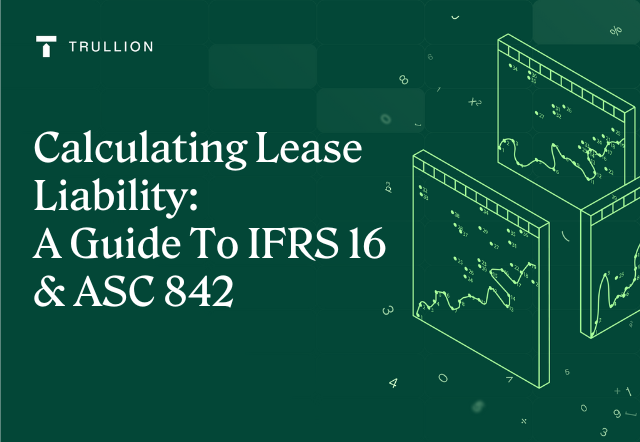Introduction
What happens when two accounting standards collide? In the case of leases in a foreign currency, this is exactly what happens.
This common scenario requires both IFRS 16 (Leases) and IAS 21 (The Effects of Changes in Foreign Exchange Rates) to be applied and touches on numerous areas, from foreign exchange gains and losses to the value of lease liabilities and right-of-use assets.
In this article, we offer insights into the complexities of managing leases in foreign currencies, exploring critical elements and best practices.
Important definitions for FX and leases
There are three major types of currency as defined by IFRS, specifically IAS 21. These are functional currency, foreign currency, and presentation currency.
The functional currency is the currency used in the “primary economic environment” in which the entity does business.
So for example, an entity headquartered in the United States will probably have US Dollars as its functional currency, whereas a company with headquarters in Europe will use Euros.
IAS 21 provides additional guidance on selecting the functional currency, including the currency that mainly influences the prices of inputs and outputs, the country whose regulations are most relevant in determining prices, and the currency impacting financing activities, among others (see paragraphs 9-14).
A foreign currency is any currency that is not the functional currency of the entity, and the presentation currency is the currency used in presenting the financial statements – if this differs from the functional currency.
The final important definition is of monetary and non-monetary items. Monetary items are defined as “units of currency held and assets and liabilities to be received or paid in a fixed or determinable number of units of currency”. Crucially, lease liabilities are included in this definition, while RoU assets are specifically excluded, i.e. non-monetary assets.
This becomes critical, especially when looking at the various components of lease accounting defined by IFRS 16.
IFRS 16 and IAS 21
According to IAS 21, at the end of each reporting period, foreign currency monetary items should be translated into the functional currency using the closing rate.
Non-monetary items that are not measured at fair value should be translated using the FX rate at the date of the transaction (the commencement date).
For IFRS 16, this means that lease liabilities should be translated into the functional currency at the end of each reporting period, while RoU assets should not be revalued.
Depreciation will be based on the rate at the commencement date, consistent with the recognition and measurement of the RoU asset. Lease payments are translated at the spot rate (IAS 21 paragraph 21), and interest expense is calculated using an average rate.
When it comes to translating from the functional currency into the presentation currency, the following steps should be applied:
- Assets and liabilities: these should be translated at the closing rate at the Statement of Financial Position date. This of course includes the RoU asset and the corresponding lease liability.
- Income and expenses: should be translated at the foreign exchange rate at the date of the transaction, although the average rate can be used (assuming FX rates haven’t fluctuated significantly).
- All exchange differences should be recognized in Other Comprehensive Income
Streamline lease accounting and foreign exchange calculations
Ensuring continuous compliance with IFRS 16 is challenging enough. When the additional requirements of foreign exchange translations are required, this task becomes even more daunting.
Manually dealing with all these foreign exchange rates within leases raises risk to uncomfortable levels; the risk of human error, the risk of non-compliance, and the headache and wasted resources of continually having to go back and make changes throughout the process.
All of this can be effortlessly managed by Trullion. Trullion’s AI-powered automated accounting software solution provides everything you need to ensure maximum accuracy and compliance, with minimum effort.
The powerful lease accounting solution provides the platform to seamlessly extract key data points from contracts, perform the most complex calculations including all the relevant foreign exchange calculations for leases, generate audit-ready reports, instantly calculate IBR, handle lease modifications, ensure the correct disclosure, and to keep you fully compliant even as standards evolve.
Trullion is your partner when it comes to IFRS 16, in all areas and all challenges. From foreign exchange translations to complete process automation, trust Trullion to handle your leases.










